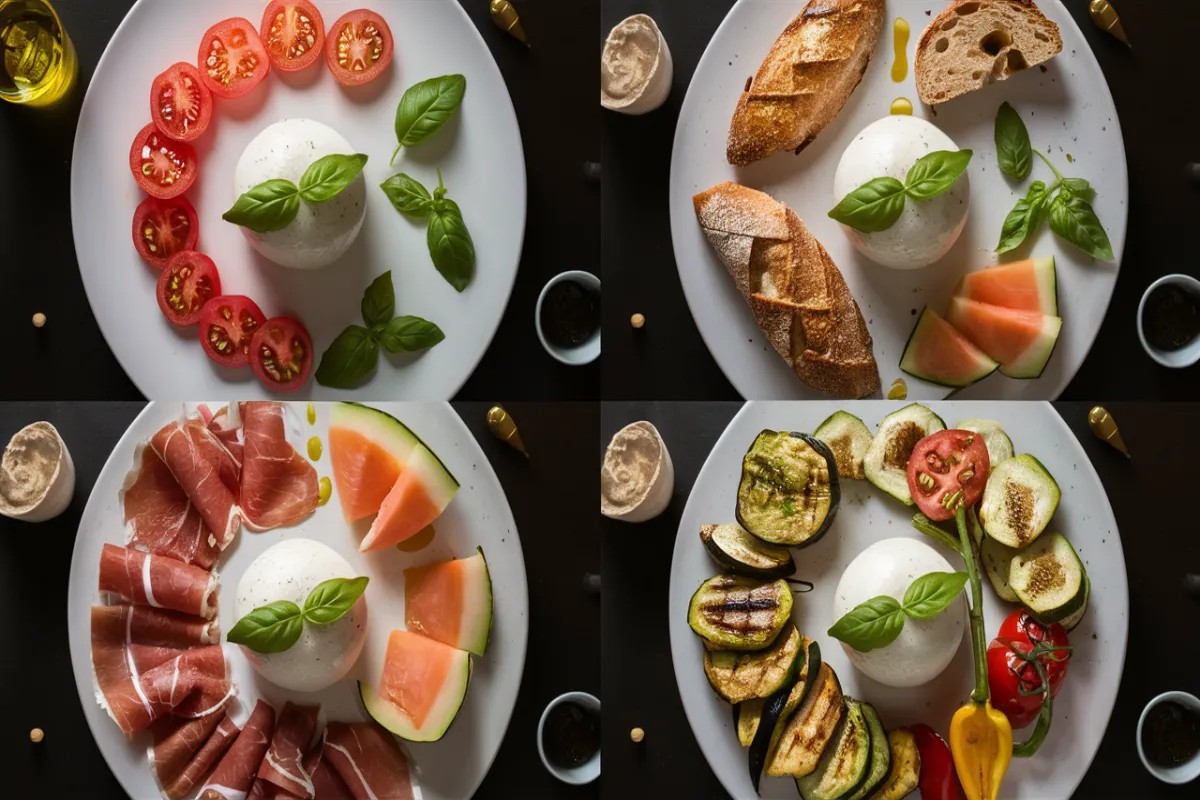Introduction
Burrata cheese is a fresh Italian cheese made from cow’s milk, combining the best of two textures: a solid outer layer of mozzarella and a soft, creamy interior of stracciatella and cream. Its name comes from the Italian word “burro,” meaning butter, which reflects its soft, buttery interior. If you’ve ever asked yourself how burrata cheese can be so creamy and delightful, or if you’ve wondered how to make burrata cheese at home, this guide is for you. We will break down the process step by step, ensuring that you understand each component and how it contributes to the overall deliciousness of this cheese.
Ingredient Breakdown for Burrata Cheese

Making burrata cheese at home requires a few simple ingredients, each playing a crucial role in achieving the right texture and flavor. Here, we break down the ingredients and their purpose, along with possible substitutions for those who may need alternatives.
1. Fresh Cow’s Milk
Fresh cow’s milk is the foundation of burrata cheese. It provides the creamy base that turns into both the mozzarella shell and the rich interior. High-quality, unpasteurized milk yields the best flavor and texture. You can also use pasteurized milk, but be sure to avoid ultra-pasteurized milk, as it does not curdle properly during the cheese-making process.
Substitutions:
If cow’s milk is unavailable or unsuitable, buffalo milk is an excellent alternative, especially since traditional burrata was made with buffalo milk. Goat milk or sheep milk can also be used, though they will result in a different flavor profile.
2. Rennet
Rennet is an enzyme that helps coagulate the milk, separating it into curds and whey. It’s essential in the cheese-making process for forming the mozzarella that will become the outer shell of burrata.
Substitutions:
Vegetarian rennet is available for those who prefer to avoid animal-derived rennet. This can be sourced from microbial or plant-based enzymes.
3. Citric Acid
Citric acid is used to acidify the milk, which is necessary for the curd formation that leads to mozzarella. It also helps enhance the mozzarella’s elasticity, which is critical for shaping the burrata shell.
Substitutions:
Lemon juice or vinegar can be used in place of citric acid, though they may impart a slight flavor. For the purest taste, stick with citric acid.
4. Cream
Cream is what makes the interior of burrata so special. Mixed with shredded mozzarella (stracciatella), the cream creates the luscious, creamy center that bursts out when you cut into the cheese.
Substitutions:
If you’re looking for a dairy-free alternative, coconut cream or almond cream can be used, though the flavor will differ slightly. Be mindful that the consistency may also be affected.
5. Salt
Salt enhances the flavor of the burrata, bringing out the creamy, rich notes. It is also added to the brine where the cheese rests, helping to preserve it while adding flavor.
Substitutions:
Sea salt or kosher salt are the best choices for burrata. Avoid using iodized table salt, as it can affect the texture and flavor of the cheese.
Step-by-Step Guide on How to Prepare Burrata Cheese
Making burrata cheese from scratch is a rewarding experience, but it does require patience and attention to detail. Follow these steps closely for the best results, and you’ll soon be enjoying homemade burrata cheese.
(Note: While we’re discussing the process, this article won’t provide a specific recipe but instead focuses on the key steps involved in making burrata.)
1. Preparing the Milk
Begin by heating your fresh cow’s milk in a large pot over medium heat. Stir in the citric acid to acidify the milk, then gradually heat it to the appropriate temperature for curdling.
2. Adding Rennet to Form Curds
Once the milk reaches the correct temperature, add rennet. Stir gently to mix it in thoroughly. After a few minutes, the milk will start to coagulate, separating into curds and whey.
3. Cutting and Heating the Curds
After the curds have formed, cut them into small cubes using a knife. This allows them to release more whey. Heat the curds again to help them firm up, then drain the whey.
4. Stretching the Mozzarella
The next step involves heating and stretching the curds to form mozzarella. This part is crucial, as it affects the elasticity of the outer shell of the burrata. Knead and stretch the curds until they are smooth and shiny.
5. Forming the Burrata Shell
After the mozzarella has been formed, shape it into small discs. These will serve as the outer shells for the burrata. The mozzarella should be pliable yet firm enough to hold its shape.
6. Making the Stracciatella Mixture
Shred some of the leftover mozzarella and mix it with cream to create the stracciatella mixture. This will be the rich filling for the burrata. Add a pinch of salt to enhance the flavor.
7. Assembling the Burrata
Place a spoonful of the stracciatella mixture in the center of each mozzarella disc. Carefully fold the mozzarella over the filling, sealing it tightly to form a ball.
8. Storing the Burrata
Once the burrata is formed, it can be placed in a salted brine to rest for a few hours. This helps preserve the cheese and infuse it with a slight saltiness.
Tips for Making the Best Burrata Cheese
Making burrata cheese at home can be a bit tricky, but with the right tips, you’ll ensure success every time. Here are some pointers for achieving the perfect burrata:
1. Use the Freshest Milk Possible
For the best flavor and texture, use fresh milk. Unpasteurized milk yields the best results, but high-quality pasteurized milk can also work. Be sure to avoid ultra-pasteurized milk.
2. Don’t Overheat the Milk
One of the most common mistakes when making burrata is overheating the milk. Keep a close eye on the temperature, and heat it slowly to prevent the curds from becoming tough.
3. Be Gentle When Handling the Curds
Handle the curds carefully, especially during the stretching process. Overhandling can cause the curds to break down, resulting in a less elastic mozzarella.
4. Salt the Stracciatella Generously
Salt is essential for enhancing the flavor of the stracciatella filling. Don’t be afraid to season it generously, as this is where much of the flavor comes from.
5. Work Quickly
Once you’ve shaped the mozzarella into balls, work quickly to fill and seal them before the cheese cools and hardens. This will help you achieve a smooth, even shape.
Pairing Suggestions for Burrata Cheese

Burrata cheese is incredibly versatile and can be paired with a wide variety of foods. Here are some ideas for how to enjoy your homemade burrata cheese:
1. Fresh Tomatoes and Basil
The classic combination of burrata with fresh tomatoes and basil is a perfect match. The acidity of the tomatoes complements the creaminess of the burrata, while the basil adds a fresh, herbal note.
2. Crusty Bread
A simple yet delicious way to enjoy burrata is with slices of crusty bread. Toast the bread and drizzle it with olive oil, then top with burrata for a satisfying snack or appetizer.
3. Prosciutto and Melon
For a sweet and savory combination, pair burrata with prosciutto and slices of melon. The sweetness of the melon balances the salty richness of the prosciutto and the creamy burrata.
4. Grilled Vegetables
Grilled vegetables such as zucchini, eggplant, and bell peppers are excellent accompaniments to burrata. The smoky, charred flavors of the vegetables contrast beautifully with the soft, creamy cheese.
5. Arugula Salad
For a lighter option, serve burrata with an arugula salad. The peppery bite of the arugula pairs nicely with the richness of the cheese. Add a drizzle of balsamic glaze for extra flavor.
Frequently Asked Questions (FAQs)
1. Can I Make Burrata Cheese Ahead of Time?
Yes, burrata cheese can be made ahead of time. Once formed, it can be stored in the refrigerator in a brine for up to 24 hours. However, burrata is best enjoyed fresh, as it loses its creamy texture after too long.
2. What Should I Do If My Burrata Isn’t Creamy Enough?
If your burrata isn’t creamy enough, it may be due to not adding enough cream to the stracciatella mixture. Be sure to use a generous amount of cream when mixing with the shredded mozzarella.
3. Can I Freeze Burrata Cheese?
It is not recommended to freeze burrata cheese, as the freezing process can affect the texture, causing the creamy center to become watery and the outer shell to lose its smoothness.
4. What Is the Difference Between Burrata and Mozzarella?
Burrata and mozzarella are similar in that they both use mozzarella, but the key difference is the filling. Burrata has a creamy center made of stracciatella and cream, while mozzarella is solid throughout.
5. Can I Use Plant-Based Ingredients to Make Burrata?
Yes, you can use plant-based ingredients to make burrata, though the texture and flavor will differ. Coconut cream or almond cream can replace dairy cream, and plant-based rennet can be used in place of animal rennet.
Tips and Tricks for Perfecting Your Burrata Cheese
If you’re striving for the ultimate homemade burrata experience, keep these extra tips in mind:
1. Experiment with Different Fillings
While the traditional burrata filling consists of mozzarella and cream, you can experiment with different additions such as herbs, truffle oil, or even roasted garlic for added flavor.
2. Try Buffalo Milk for Authenticity
For a more authentic flavor, try making burrata with buffalo milk. It has a richer, slightly tangier flavor than cow’s milk and is often used in traditional burrata recipes.
3. Serve Burrata at Room Temperature
Burrata is best served at room temperature, as this allows the creamy center to become soft and luscious. Remove the burrata from the refrigerator about 30 minutes before serving.
Conclusion
Burrata cheese is one of the most luxurious and versatile cheeses, offering a delightful combination of textures and flavors. Whether you’re making it from scratch or enjoying it as part of a dish, burrata cheese is a culinary masterpiece that adds richness to any meal. From fresh salads to indulgent appetizers, burrata cheese can elevate even the simplest ingredients, making it a beloved addition to your culinary repertoire. With the tips and guidance provided in this article, you can confidently create and enjoy burrata cheese in a variety of delicious ways.

